Items
Tag
University of Michigan
-
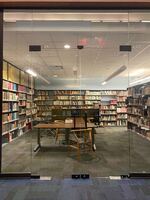 Middle Eastern and North African Studies Library Located on the third floor of the South Thayer Building at the University of Michigan Ann Arbor campus, the Middle Eastern and North African Studies library is also a reading room and manuscripts library that is only part of the Middle East Studies collection across various locations on campus. This library is especially targeted to graduate students of University of Michigan, especially those in the Department Middle Eastern Studies, but open to any researchers interested in visiting.
Middle Eastern and North African Studies Library Located on the third floor of the South Thayer Building at the University of Michigan Ann Arbor campus, the Middle Eastern and North African Studies library is also a reading room and manuscripts library that is only part of the Middle East Studies collection across various locations on campus. This library is especially targeted to graduate students of University of Michigan, especially those in the Department Middle Eastern Studies, but open to any researchers interested in visiting. -
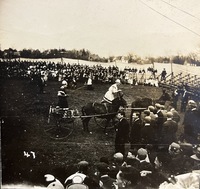 Chariot Race One of several activities in the Union Circus was a student-led chariot race. Two men, dressed in Roman costumes, race in chariots pulled by horses. A large crowed watches the performance from the sidelines of the Ferry Field ring.
Chariot Race One of several activities in the Union Circus was a student-led chariot race. Two men, dressed in Roman costumes, race in chariots pulled by horses. A large crowed watches the performance from the sidelines of the Ferry Field ring. -
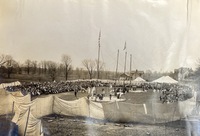 The Main Performance In this image, multiple students in the Union Circus perform for an audience. The circus ring, located in Ferry Field, is surrounded by bleachers full of people. Students dress in blackface, clown attire, and as various animals.
The Main Performance In this image, multiple students in the Union Circus perform for an audience. The circus ring, located in Ferry Field, is surrounded by bleachers full of people. Students dress in blackface, clown attire, and as various animals. -
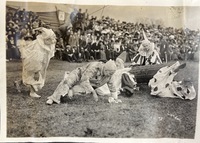 The "Log" Inscribed "721 Lyndon", this image shows five clowns participating in the Union Circus. Beneath the image is the phrase "The 'Log'". The circus ring, located in Ferry Field, is surrounded by bleachers full of people. They watch as the clowns tumble a long-like object.
The "Log" Inscribed "721 Lyndon", this image shows five clowns participating in the Union Circus. Beneath the image is the phrase "The 'Log'". The circus ring, located in Ferry Field, is surrounded by bleachers full of people. They watch as the clowns tumble a long-like object. -
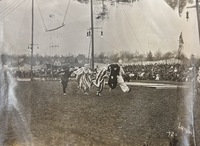 Clowns in Action Inscribed "720 Lyndon", this image shows four clowns participating in the Union Circus. The circus ring, located in Ferry Field, is surrounded by bleachers full of people. They watch as the clowns run across the arena.
Clowns in Action Inscribed "720 Lyndon", this image shows four clowns participating in the Union Circus. The circus ring, located in Ferry Field, is surrounded by bleachers full of people. They watch as the clowns run across the arena. -
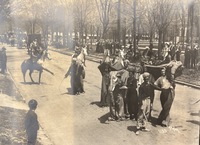 Elephants at "Parade Rest" Taken from the Kapp scrapbook, this image is inscribed with "Lyndon. 1133" and captioned with sentence "Elephants at 'Parade Rest'". It depicts the Union Circus parade, temporarily paused next to the university campus. White students clad in blackface perform various roles as either elephant trainer or indigenous person. Their costumes depict stereotypes of native peoples and of South Asians. Circus goers watch with interest from the sidelines. The Ann Arbor trolly tracks can be seen along the grass.
Elephants at "Parade Rest" Taken from the Kapp scrapbook, this image is inscribed with "Lyndon. 1133" and captioned with sentence "Elephants at 'Parade Rest'". It depicts the Union Circus parade, temporarily paused next to the university campus. White students clad in blackface perform various roles as either elephant trainer or indigenous person. Their costumes depict stereotypes of native peoples and of South Asians. Circus goers watch with interest from the sidelines. The Ann Arbor trolly tracks can be seen along the grass. -
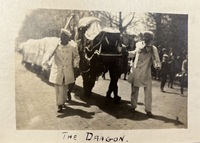 The Dragon The image is inscribed "THE DRAGON". As part of the Union Circus' parade, students constructed a long dragon costume to walk down State Street. The guides, both white men, wear a potentially Asian-inspired outfit and some form of blackface. Though unclear, it's probable these students are mimicking Asian men.
The Dragon The image is inscribed "THE DRAGON". As part of the Union Circus' parade, students constructed a long dragon costume to walk down State Street. The guides, both white men, wear a potentially Asian-inspired outfit and some form of blackface. Though unclear, it's probable these students are mimicking Asian men. -
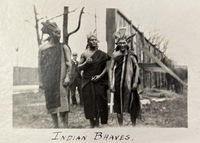 Indian Braves Three white men, costumed as stereotypical Native Americans, wear thin gowns and feathered headdresses. Additionally, the men are covered in brown makeup to mimic some Indigenous skin tones. The photograph is inscribed "INDIAN BRAVES". It's likely these men are part of the Union Circus' "Michigamua Indians" student group. Importantly, all members of this group were white men.
Indian Braves Three white men, costumed as stereotypical Native Americans, wear thin gowns and feathered headdresses. Additionally, the men are covered in brown makeup to mimic some Indigenous skin tones. The photograph is inscribed "INDIAN BRAVES". It's likely these men are part of the Union Circus' "Michigamua Indians" student group. Importantly, all members of this group were white men. -
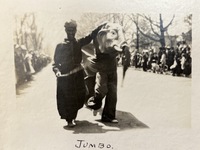 Jumbo the Elephant One of several blackface performances in the Union Circus, "Jumbo" the elephant and his guide drew much attention from the watching crowds. In place of real exotic animals, students dressed in animal costumes. The elephant, dubbed "Jumbo" by the inscription, required two students to act as legs. The white man guiding Jumbo wears a turban and blackface. The phrase "All Together Julia-" is inscribed under the second image in the Low scrapbook.
Jumbo the Elephant One of several blackface performances in the Union Circus, "Jumbo" the elephant and his guide drew much attention from the watching crowds. In place of real exotic animals, students dressed in animal costumes. The elephant, dubbed "Jumbo" by the inscription, required two students to act as legs. The white man guiding Jumbo wears a turban and blackface. The phrase "All Together Julia-" is inscribed under the second image in the Low scrapbook. -
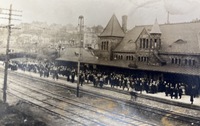 The Circus Comes to Town Days before the Union Circus' opening event, a delivery of circus material by train was anticipated. Captured by image in the Low scrapbook, crowds wait to collect the equipment at the old Michigan Central Depot before it was decommissioned.
The Circus Comes to Town Days before the Union Circus' opening event, a delivery of circus material by train was anticipated. Captured by image in the Low scrapbook, crowds wait to collect the equipment at the old Michigan Central Depot before it was decommissioned. -
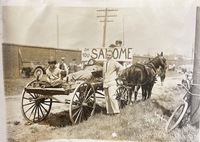 Oh You Salome Found within the Frank Kapp scrapbook, this image displays two children and two men, one wearing a woman's dress, resting on a Union Circus wagon. A sign reading "Oh You Salome" sits in the center of the group, identifying the men as part of the titular side show performance. Beneath the image is the inscription "Oh you kid!!!". The performance may be anti-Semitic in nature. The Biblical Salome was a Jewish princess often blamed for the murder of John the Baptist. Several plays and operatic productions about Salome were popular prior to 1909.
Oh You Salome Found within the Frank Kapp scrapbook, this image displays two children and two men, one wearing a woman's dress, resting on a Union Circus wagon. A sign reading "Oh You Salome" sits in the center of the group, identifying the men as part of the titular side show performance. Beneath the image is the inscription "Oh you kid!!!". The performance may be anti-Semitic in nature. The Biblical Salome was a Jewish princess often blamed for the murder of John the Baptist. Several plays and operatic productions about Salome were popular prior to 1909. -
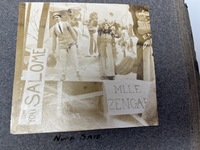 Nuff Said Despite the inscription "NUFF SAID," there is sizable uncertainty surrounding the activity captured on the image. Two men, one wearing a woman's dress, stand on a stage before a painting of stereotypical Middle Eastern peoples. A sign reading "Oh You Salome" rests near the side show stage. The combination of these elements suggests the performance may be anti-Semitic in nature. The Biblical Salome was a Jewish princess often blamed for the murder of John the Baptist. Several plays and operatic productions about Salome were popular prior to 1909.
Nuff Said Despite the inscription "NUFF SAID," there is sizable uncertainty surrounding the activity captured on the image. Two men, one wearing a woman's dress, stand on a stage before a painting of stereotypical Middle Eastern peoples. A sign reading "Oh You Salome" rests near the side show stage. The combination of these elements suggests the performance may be anti-Semitic in nature. The Biblical Salome was a Jewish princess often blamed for the murder of John the Baptist. Several plays and operatic productions about Salome were popular prior to 1909. -
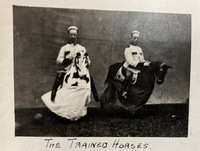 The Trained Horses "THE TRAINED HORSES", as the inscription reads, are two students dressed as both horse and rider. This performers were two of many people costumed as animals in the Union Circus.
The Trained Horses "THE TRAINED HORSES", as the inscription reads, are two students dressed as both horse and rider. This performers were two of many people costumed as animals in the Union Circus. -
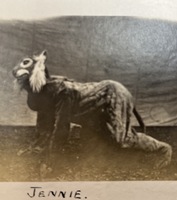 The Union Circus "Tiger" The inscription accompanying this image reads "JENNIE". The name may refer to either the student dressed as a tiger or the tiger character itself. This performer was one of many costumed as an animal in the Union Circus.
The Union Circus "Tiger" The inscription accompanying this image reads "JENNIE". The name may refer to either the student dressed as a tiger or the tiger character itself. This performer was one of many costumed as an animal in the Union Circus. -
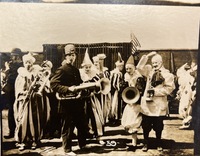 A Bunch of Clowns The popularity of brass bands at the beginning of the 20th century is made evident by this image of musical performers in the Union Circus. The band, clad in clown costumes and police uniforms, holds a variety of instruments, including: trumpets, trombones, and tubas. The group of more than 12 men appears to be waiting for their performance to begin. The inscription below the photograph reads "A Bunch of Clowns"
A Bunch of Clowns The popularity of brass bands at the beginning of the 20th century is made evident by this image of musical performers in the Union Circus. The band, clad in clown costumes and police uniforms, holds a variety of instruments, including: trumpets, trombones, and tubas. The group of more than 12 men appears to be waiting for their performance to begin. The inscription below the photograph reads "A Bunch of Clowns" -
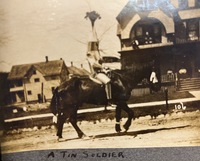 A Tin Soldier A student in the Union Circus dubbed "A Tin Soldier" by the inscription under the image, trots through Ann Arbor on his dark horse. He is costumed from head to toe in metal material to appear as a knight. A large plum sticks up from the top of his helmet. Based on the circus' known parade route, the location the image was taken is likely along State Street.
A Tin Soldier A student in the Union Circus dubbed "A Tin Soldier" by the inscription under the image, trots through Ann Arbor on his dark horse. He is costumed from head to toe in metal material to appear as a knight. A large plum sticks up from the top of his helmet. Based on the circus' known parade route, the location the image was taken is likely along State Street. -
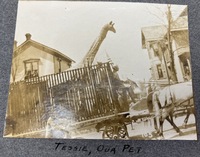 Tessie, Our Pet In lieu of real exotic animals, students crafted replicas for actors to wear during the parade. A giraffe, named "Tessie" according to the image's description, was a highlight of the event. One image shows the costumed students being driven downtown in a caged wagon, while the other shows the students stationed somewhere, possibly Ferry Field, with another student.
Tessie, Our Pet In lieu of real exotic animals, students crafted replicas for actors to wear during the parade. A giraffe, named "Tessie" according to the image's description, was a highlight of the event. One image shows the costumed students being driven downtown in a caged wagon, while the other shows the students stationed somewhere, possibly Ferry Field, with another student. -
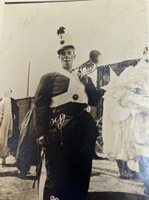 The Trumpeter Clown Found in the Low scrapbook, this image depicts a member of the Union Circus dressed in clown clothing and face-paint. He stands near other costumed individuals and a caged wagon. Based on the clown's trump, he was likely in the brass band that moved down State Street.
The Trumpeter Clown Found in the Low scrapbook, this image depicts a member of the Union Circus dressed in clown clothing and face-paint. He stands near other costumed individuals and a caged wagon. Based on the clown's trump, he was likely in the brass band that moved down State Street. -
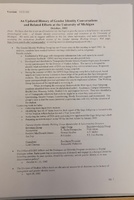 An Updated History of Gender Identity Conversations and Related Efforts at the University of Michigan A timeline, as of October 2002, of conversations, events, and initiatives at the University of Michigan concerning gender identity. Many of the updates since the 2001 file are focused around the Gender Identity Working Group.
An Updated History of Gender Identity Conversations and Related Efforts at the University of Michigan A timeline, as of October 2002, of conversations, events, and initiatives at the University of Michigan concerning gender identity. Many of the updates since the 2001 file are focused around the Gender Identity Working Group. -
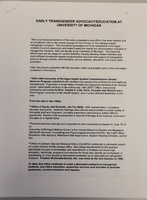 Early Transgender Advocacy/Education at University of Michigan An historical narrative documenting early transgender advocacy efforts by the University of Michigan. It presents transgender advocacy as a work in progress and lists areas the University has already made progress in.
Early Transgender Advocacy/Education at University of Michigan An historical narrative documenting early transgender advocacy efforts by the University of Michigan. It presents transgender advocacy as a work in progress and lists areas the University has already made progress in. -
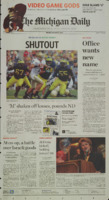 LGBT Affairs Office name change (2 pages), 2007 A digital scan of a page of the Michigan Daily from September 17th, 2007, featuring two halves of an article about the search for a more inclusive name for the University's Office of Lesbian Gay and Bisexual Affairs—the future Spectrum Center. There was growing support for a name that would be more inclusive for transgender and other queer students. Some decried the initiative as taking inclusiveness too far.
LGBT Affairs Office name change (2 pages), 2007 A digital scan of a page of the Michigan Daily from September 17th, 2007, featuring two halves of an article about the search for a more inclusive name for the University's Office of Lesbian Gay and Bisexual Affairs—the future Spectrum Center. There was growing support for a name that would be more inclusive for transgender and other queer students. Some decried the initiative as taking inclusiveness too far. -
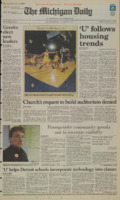 "Living Outside the World of Sexual Categories" (2 pages), 2004 A digital scan of two pages of the Michigan Daily from November 18th, 2004, featuring two halves of an article about the experiences of transgender students at UM. This covers the 2004 University's Report of the Task Force on the Campus Climate for Transgender, Bisexual, Lesbian and Gay Faculty, Staff and Students. This includes personal accounts from transgender students (Denise Brogan, André Wilson, Stephen Rassi) and information spreading awareness about the personal and legal struggles of transgender and transsexual individuals in general.
"Living Outside the World of Sexual Categories" (2 pages), 2004 A digital scan of two pages of the Michigan Daily from November 18th, 2004, featuring two halves of an article about the experiences of transgender students at UM. This covers the 2004 University's Report of the Task Force on the Campus Climate for Transgender, Bisexual, Lesbian and Gay Faculty, Staff and Students. This includes personal accounts from transgender students (Denise Brogan, André Wilson, Stephen Rassi) and information spreading awareness about the personal and legal struggles of transgender and transsexual individuals in general. -
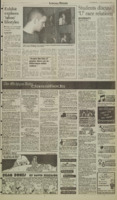 Transgender/Transsexual photo exhibit, Michigan Union Art Lounge, 1997 A digital scan of a page of the Michigan Daily from December 5th, 1997, featuring an article about the photo exhibit "Crossing Over: Images of Transgender Performance Across Cultures" and a photo of a student viewing the exhibit. This exhibit showcased photos of Indian kinnar, drag queens in Greenwich Village, and other individuals taking part in "cross-dressing" traditions. These photos were the result of fieldwork by anthropology professor Sarah Caldwell and graduate student Brian Mooney.
Transgender/Transsexual photo exhibit, Michigan Union Art Lounge, 1997 A digital scan of a page of the Michigan Daily from December 5th, 1997, featuring an article about the photo exhibit "Crossing Over: Images of Transgender Performance Across Cultures" and a photo of a student viewing the exhibit. This exhibit showcased photos of Indian kinnar, drag queens in Greenwich Village, and other individuals taking part in "cross-dressing" traditions. These photos were the result of fieldwork by anthropology professor Sarah Caldwell and graduate student Brian Mooney. -
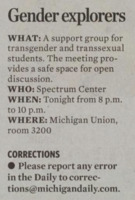 Spectrum Center Gender Explorers support group ad, Sept. 14, 2009 Zoomed-in screenshot of a digital scan of a page of the Michigan Daily from September 14th, 2009, featuring an ad for a Spectrum Center support group called Gender Explorers. This was "a support group for transgender and transsexual students" hosted by the Spectrum Center.
Spectrum Center Gender Explorers support group ad, Sept. 14, 2009 Zoomed-in screenshot of a digital scan of a page of the Michigan Daily from September 14th, 2009, featuring an ad for a Spectrum Center support group called Gender Explorers. This was "a support group for transgender and transsexual students" hosted by the Spectrum Center. -
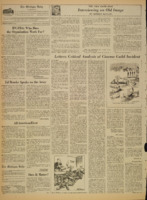 Opinion on 1967 arrest of students for screening transvestite film "Flaming Creatures" A digital scan of a page of the Michigan Daily from March 28th, 1967, featuring an editorial letter from Professor John E. Powers. Dr. Powers of the College of Engineering offered a "critical analysis" of the "Cinema Guild Incident," in which 4 UM students were arrested in January of that year for showing the experimental transvestite film "Flaming Creatures" on campus.
Opinion on 1967 arrest of students for screening transvestite film "Flaming Creatures" A digital scan of a page of the Michigan Daily from March 28th, 1967, featuring an editorial letter from Professor John E. Powers. Dr. Powers of the College of Engineering offered a "critical analysis" of the "Cinema Guild Incident," in which 4 UM students were arrested in January of that year for showing the experimental transvestite film "Flaming Creatures" on campus.